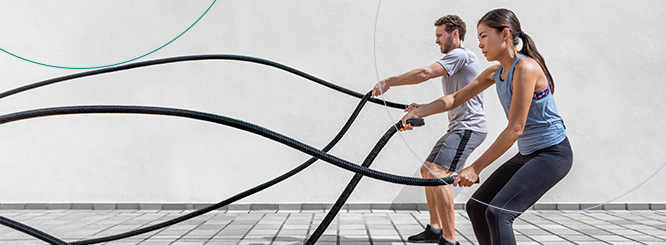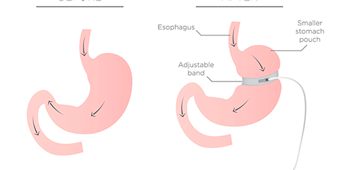
A healthy and successful recovery following a gastric sleeve can open countless doors when it comes to new experiences or following through with activities you gave up due to health concerns. Whether it’s returning to work and exploring new professional settings or taking up hobbies in your free time, being at your best is essential for thriving in your new lifestyle.
One of the most important aspects of having a successful postoperative journey is exercise, since adding a workout to your daily routine, as well as a healthy diet, is key to ensuring that you don’t regain the weight that was lost after your gastric sleeve. It’s no secret that exercise has proven to show positive effects on a person’s overall health, both physically and mentally, regardless of their current weight or fitness goals. These benefits can be achieved through different types of exercise routines, such as weight training, cardio workouts, resistance training, or pilates.
If you’re new to working out, you’re probably wondering which exercise is best for you and there are plenty of options to choose from. Cardio workouts are usually the go-to for people that are looking to shed some extra pounds because of their fast-paced, high-intensity routines. Weight training is another workout recommended for building strength and for losing weight without decreasing the body’s muscle mass.
While these types of workouts are effective, they’re not the only available options for people looking to embark on their weight loss journey.
However, there’s another workout option that can be available for you following a gastric sleeve and it’s one of the most practiced exercise methods around the world. We’re talking about CrossFit and for this article we will discuss if it’s a good option for bariatric patients who’ve had a gastric sleeve. CrossFit is a high-intensity workout regime and our team at LIMARP® is here to guide you through your recovery process so that you start going after your goals in a safe and healthy way.
Before going any further, we recommend that you speak to your CrossFit instructor if you’re recovering from an injury or any type of surgery. This will allow them to support you at a greater capacity and prevent you from sustaining further injury or sprains, especially if you’re starting at a beginner level.
The Gastric Sleeve: What Is It
The gastric sleeve is a restrictive procedure that consists in reducing the size of the stomach by removing approximately 75% to 80% of it from the body, leaving only a small part that resembles a sleeve. By reducing the size of the stomach, the gastric sleeve only allows the ingestion of a certain amount of food, allowing the patient to reach or maintain a healthy weight. It also alleviates or improves conditions for people struggling with diabetes, sleep apnea, and hypertension.
Aside from being one of the most effective and safest types of bariatric surgery, the gastric sleeve has shown to help with gastric emptying[1], as well as reducing nausea and vomiting. This means the quality of life and overall health of people who get the gastric sleeve improves significantly.
The recovery from this surgery is faster than other bariatric procedures. Patients may expect a post-operative stay of 1 to 2 days in the hospital’s recovery room, and mandatory rest for four to six weeks. During the first weeks of recovery, the patient should follow a strict only-liquids diet, which will progressively move to purees and solids.
To achieve the best possible benefits from your surgery, it is important that you work with the bariatric nutrition experts at LIMARP®. If you overeat or consume a high-calorie diet, your stomach can stretch and your chances of successful weight loss could decrease.
Our treatment includes a long-term follow with which we monitor your progress and provide guidance for maintaining your optimal weight and health. We are committed to making you achieve your major goals with our treatment.
Playing Sports After the Gastric Sleeve
There are many physical activities that you can perform once you’ve recovered from your surgery, but one thing that you should keep in mind is that you must start small. We understand that you may be eager to dive in at full capacity, but it is imperative that you rest and limit your overall activity to avoid disrupting the recovery process. Heavy lifting and exercise could cause serious complications, such as a hernia in one of your wounds, so you are encouraged to wait the recommended time to engage in certain activities. Most patients can expect to return to work and normal activities in about four to six weeks.
So, where to begin?
If CrossFit is the first physical activity you want to try out, we recommend that you build your way up to it first; this means slowly increasing your strength and conditioning by trying light workouts that mainly consist of little movement, such as short walks and stretching. Make sure to avoid lifting heavy loads or trying out exercises that demand too much of your body.
In the first few months of your recovery, we recommend aerobic exercises, such as walking and biking to get the blood flowing and improve your heart rate; swimming is also recommended, as well as yoga and pilates. You should find what feels good for your body and state of mind and your doctor can also recommend exercise routines that push you to improve without hurting yourself.
For more intense workouts, such as weight lifting, running long distances, and CrossFit, we recommend that you wait at least six months to make sure that your body has fully recovered and that you don’t suffer any significant injuries. When it comes to these types of activities, especially CrossFit and resistance training, it’s important to be guided by a certified instructor so that they can help you master the correct forms for each exercise, as well as tell you how and when you should be progressing in the amount of weight you lift. This will allow you to not only keep a healthy body weight, but also to reach more advanced levels of these exercises.
A Deeper Look Into CrossFit
If you’re interested in trying CrossFit once you’ve recovered from your gastric sleeve surgery, it’s important that you learn more about this sport, as well as its upsides and downsides. Once again, you should wait until your doctor gives you the green light so that you can participate in high-intensity workouts.
CrossFit was developed at the start of the new millennium and it’s described as “a branded fitness regimen that involves constantly varied functional movements performed at high intensity”[2], this means that it’s a multidisciplinary workout regime that includes practices such as high-intensity interval training (HIIT), Olympic weightlifting, plyometrics, powerlifting, gymnastics, kettlebell lifting, and calisthenics, among others. Each of these previous exercises are great on their own and the goal of the people who developed CrossFit was to “develop fitness in what the company deems to be the ten components of physical fitness: cardiovascular/respiratory endurance, stamina, strength, flexibility, power, speed, coordination, agility, balance, accuracy”[3].
The gyms that have become affiliated with CrossFit typically offer hour-long classes that are known as Workouts of the Day or WODs. What differentiates these WODs from other types of workouts is that they’re competition based, meaning that they encourage improvement by ranking the effectiveness of each participant. Aside from these workouts, a regular CrossFit session also includes warm-up and cool down sections to prevent injuries before and after your session.
Taking into account that CrossFit combines many types of exercises, we recommend that, as a bariatric patient who has fully recovered from the gastric sleeve, take things slow and to not push yourself to the point of injury. We also want to highlight the importance of your mental health and to view the competitive side of CrossFit as an invitation to improve your lifestyle and reach your personal goals, not as a way to compare yourself to others to the point of discouragement.
CrossFit: Its Benefits and Risks
Any type of physical activity is necessary once you’ve recovered from bariatric procedures like the gastric sleeve, not only for maintaining your body at a healthy weight, but to improve other aspects of your life, such as your strength, coordination, flexibility, and mental health. CrossFit offers several of these benefits once you start practicing it and we’d like to discuss some of them.
- Improvement in Physical Strength
The high-intensity performed in CrossFit can help you gain muscle strength and stamina, especially if you add weight training and progressively increase your load once you’ve mastered certain exercises. The amount of repetitions that are done on each WOD can also help you increase your physical strength and muscle mass.
- Better Aerobic Fitness
CrossFit’s high-intensity power training allows you to increase the maximum amount of oxygen you can utilize during exercise[4]. However, compared to other aerobic exercises, such as swimming or biking, it’s hard to say which is better for this improvement in aerobic performance.
- Agility, Flexibility, and Balance
CrossFit mimics and favors functional movements that we tend to carry out in our daily life, such as squats and overhead presses. These exercises reduce the risk of getting hurt, not only when exercising, but when performing day-to-day activities that are strenuous.
While the benefits of CrossFit are a good sign to try it out, there are also risks for which this type of workout has been highly criticized and it’s important to learn about them, especially if you’re a bariatric patient who has recently recovered from gastric sleeve surgery.
Although the use of functional movements within the workouts can be beneficial, CrossFit has been criticized for “using dangerous movements and inappropriate levels of intensity”[5]. Another reason why CrossFit may be dangerous is because of its link to exertional rhabdomyolysis, which is the breakdown of muscle from extreme physical exertion. Other risks include low back pain, rotator cuff tendonitis, tennis elbow, knee injuries, and Achilles tendonitis.
Injuries are part of any physical exercise, but their risk can be lowered if you practice them in a safe manner and by following guided instructions. Part of working out means listening to your body and to learn when to stop if you’re starting to feel pain that’s not associated with the exertion that usually comes with CrossFit or any other type of workout.
Contact Us to Learn More
If you’re interested in CrossFit following a bariatric surgery, schedule an appointment with one of our doctors. We can help determine the right treatment for you. Contact us online anytime or give us a call at (619) 373-0229.
References
- [1] Bankole Samuel, Kofi Atiemo, Phillip Cohen, Donald Czerniach, John Kelly, and Richard Perugini.Bariatric Surgical Practice and Patient Care.Jun 2016.84-89.http://doi.org/10.1089/bari.2015.0052
- [2] “Understanding CrossFit”. http://journal.crossfit.com/2007/04/understanding-crossfit-by-greg.tpl. (Accessed September 15, 2022).
- [3] “CrossFit Guide for Beginners: What You Must Know Before You Start”. https://garagegympower.com/crossfit-beginners-guide/. (Accessed September 15, 2022).
- [4] “What Are the Benefits of CrossFit and Is It Safe?”. https://www.healthline.com/health/exercise-fitness/crossfit-benefits. (Accessed September 15, 2022).
- [5] “Is CrossFit Dangerous?”. https://www.bloomberg.com/news/articles/2014-09-04/crossfit-fights-injury-reputation-as-community-aspect-fuels-growth. (Accessed September 15, 2022).


